CXM vs CRM: What’s the Difference?
While CXM vs CRM are crucial components of a business's strategy to engage with customers effectively, they serve different purposes and focus on distinct aspects of the customer journey.

While CXM vs CRM are crucial components of a business's strategy to engage with customers effectively, they serve different purposes and focus on distinct aspects of the customer journey.

The two terms that often come up in the world of customer relationship management are CXM and CRM. But what’s the difference between the CXM vs CRM? Are they interchangeable or do they offer distinct approaches to managing customer relationships?
The advancement in technology and the increasing importance of personalized customer experiences have pushed businesses to seek effective ways of engaging with their customers. After all, 81% of people claim that receiving good customer service makes them more likely to make another purchase.
Understanding the differences between CXM (Customer Experience Management) and CRM (Customer Relationship Management) is crucial for businesses looking to optimize their customer interactions. They do share a common goal of improving customer satisfaction, but each plays a unique role in achieving this objective.
Customer Experience Management (CXM) refers to the practice of optimizing the touchpoints to create positive, memorable experiences that build customer loyalty and drive business growth. It involves understanding the customer’s journey, anticipating their needs and delivering seamless, personalized experiences across all channels. Businesses analyze the customer data, implement customer-centric processes and continuously optimize the customer experience based on the insights.
Key objectives:
Explore the multifaceted advantages of implementing a robust customer experience management strategy and understand why it should be at the forefront of the business objectives.
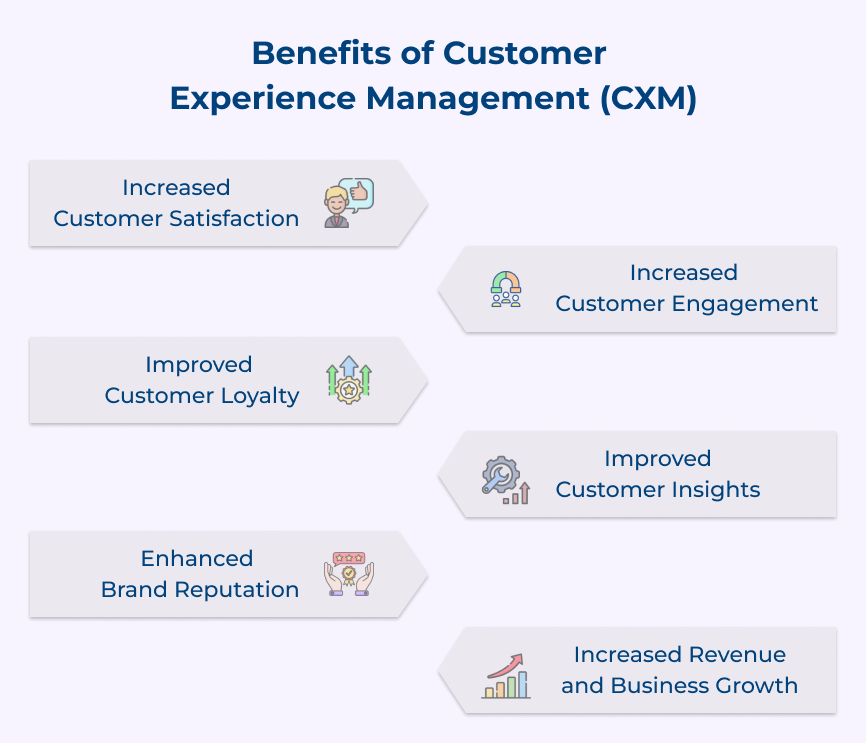
CXM focuses on understanding and meeting customer expectations. Businesses can enhance the overall customer experience by implementing effective CXM strategies, resulting in increased customer satisfaction. Satisfied customers are more likely to become repeat customers and recommend the brand to others.
Customers who have a positive experience with a brand are more likely to remain loyal to that brand. 88% of consumers say it takes three or more purchases to build brand loyalty. CXM helps build strong relationships with customers by prioritizing their needs and providing personalized experiences. It facilitates loyalty and reduces customer churn rate, leading to long-term business growth.
A positive customer experience can significantly impact a company’s reputation. When customers have a positive experience, they are more likely to share it on social media, review sites and through word-of-mouth. The positive feedback helps build a strong brand image, attracting more customers and setting the business apart from its competitors.
CXM emphasizes engaging with customers at multiple touchpoints throughout their journey with the brand. Businesses can foster a sense of involvement by actively involving customers and addressing their concerns. The increased engagement leads to higher customer retention rates and improved business performance.
CXM involves analyzing customer data to better understand their preferences, behaviors, and needs. The valuable information can be used to tailor marketing strategies, develop targeted campaigns and make informed business decisions. Gaining deeper insights into the customers allows businesses to optimize their solutions to better meet customer expectations, ultimately driving growth and profitability.
CXM ultimately translates into increased revenue and business growth. Businesses can attract more customers, retain existing ones, and promote repeat purchases by focusing on enhancing the customer experience at every touchpoint. Satisfied customers are more likely to spend more with the brand and become advocates, bringing in more customers through referrals.
Let’s dive into the key features of CXM that can transform how you connect with customers and drive your business into a customer-centric success.
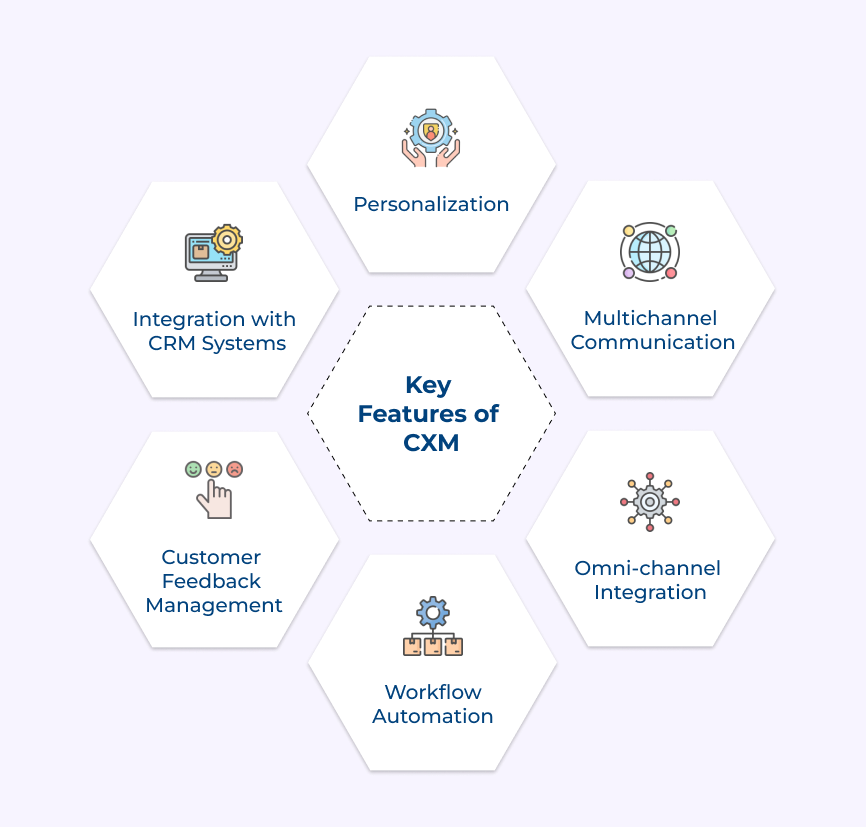
Personalization is the cornerstone of CXM. It involves tailoring products, services, and experiences to meet the specific preferences of individual customers. Businesses can create personalized marketing campaigns, recommendations, and offers by analyzing customer data. 78% of consumers are more likely to recommend a brand that personalizes and helps in repeat purchases.
Customers interact with businesses through various channels, including websites, social media, email and mobile apps. CXM platforms allow businesses to streamline and manage interactions across different channels. It ensures that customers receive consistent and cohesive experiences, regardless of the channel they use.
Customers expect a seamless and integrated experience across all touchpoints. CXM platforms enable businesses to integrate different channels and touchpoints, providing customers with a consistent experience. The integration eliminates information silos, improves communication, and enhances customer satisfaction. Brands with top omnichannel customer engagement see a 9.5% yearly increase in annual revenue.
Gathering and managing customer feedback is essential for improving CXM. CXM platforms include various features, which enable businesses to collect, analyze, and act upon customer feedback. Businesses can enhance customer satisfaction by addressing customer concerns and implementing suggested improvements.
CXM platforms offer workflow automation capabilities, allowing businesses to automate repetitive tasks and processes. Automating tasks like customer onboarding, support ticket management, and follow-ups allows companies to free up valuable time. It leads to increased efficiency and allows employees to focus on more strategic initiatives that directly impact customer experience.
CXM and Customer Relationship Management (CRM) systems work hand-in-hand to manage customer interactions and improve relationship-building efforts. Integration between CXM and CRM systems ensures that all customer data is centralized and accessible in one place. The unified view of customer information enables businesses to deliver personalized experiences, track customer journeys and provide better support.
Customer Relationship Management (CRM) can be defined as a strategic approach to managing an organization’s relationships with customers, clients and sales prospects. It is a comprehensive system that helps businesses understand their customers better, improve customer satisfaction and eventually drive sales growth.
CRM works by collecting customer data from various touchpoints, such as sales, marketing, and customer service. The data is then used to gain insights into customer behaviors, preferences and pain points. Businesses can leverage the information to tailor their products, services and communication to better meet the needs of their customers.
Key objectives:
Let us discuss the benefits of CRM and understand why businesses should invest in this powerful tool.
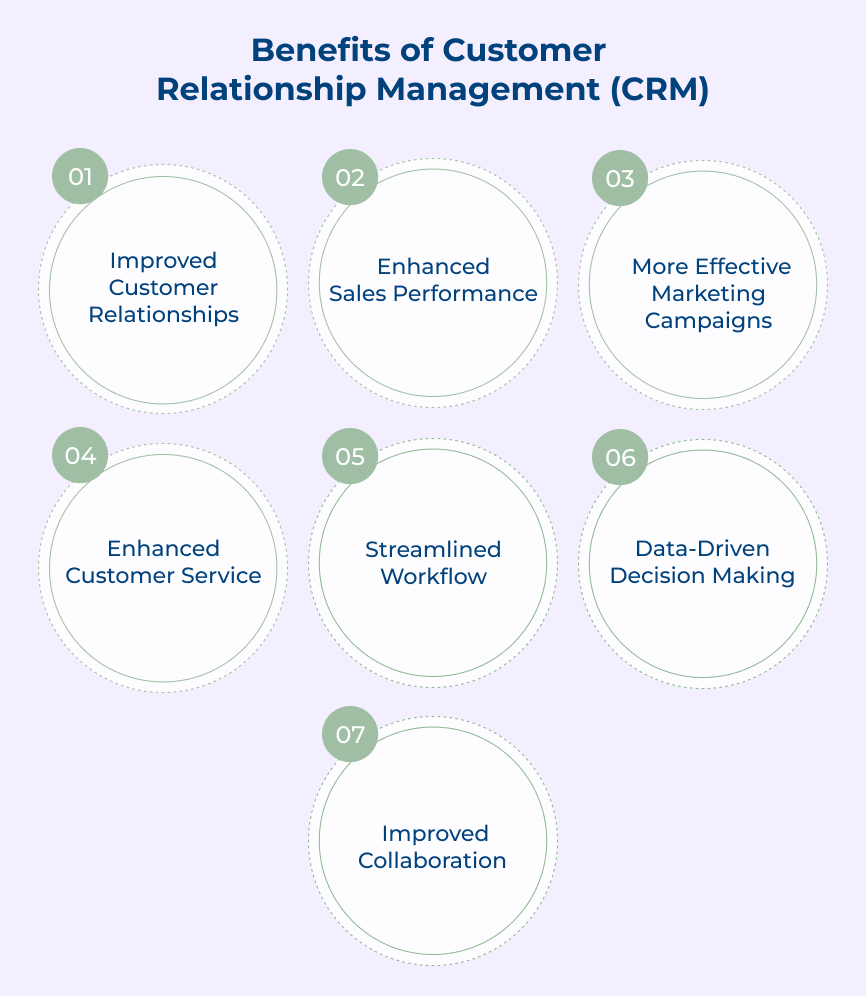
CRM allows businesses to centralize customer information, giving them a comprehensive view of customers’ preferences, buying history, and interactions. The data helps organizations personalize their interactions and deliver superior customer experiences, promoting stronger relationships.
CRM helps sales teams manage leads, track opportunities and automate sales processes. Sales representatives can prioritize their efforts, identify cross-selling or upselling opportunities, and close deals faster by having access to real-time customer data. It leads to increased sales productivity and better revenue generation.
CRM enables businesses to segment their customer base and create targeted marketing campaigns. Companies can identify customer preferences, purchase patterns, and demographic information by analyzing customer data. It allows them to send personalized and relevant marketing messages.
Customer service teams can access a customer’s complete interaction history, including previous purchases, inquiries, and support tickets. It helps agents provide efficient customer service by quickly understanding the customer’s needs and delivering tailored solutions. CRM also enables businesses to track customer issues, measure response times, and identify areas for improvement.
CRM automates various processes, reducing manual effort and eliminating the risk of human error. It provides a centralized platform for managing customer data, scheduling appointments, sending reminders, and tracking follow-ups. Businesses can streamline workflow, improve efficiency, and enable employees to focus on higher-value activities. Workflow automation statistics suggest that repetitive task time is reduced by 60 – 95%.
CRM provides businesses with valuable insights into customer behavior, market trends, and sales performance. Enterprises can make informed decisions regarding product development, pricing strategies, marketing campaigns, and customer retention efforts. Data-driven decision-making increases the likelihood of success and helps businesses stay ahead of competitors.
CRM facilitates better collaboration and communication among different departments within an organization. Sales, marketing, and customer service teams can access the same customer data to share information seamlessly. It leads to better coordination, faster response times and a more comprehensive understanding of customer needs.
Let’s dive into the key features of CRM systems that can elevate your business and redefine customer interactions.
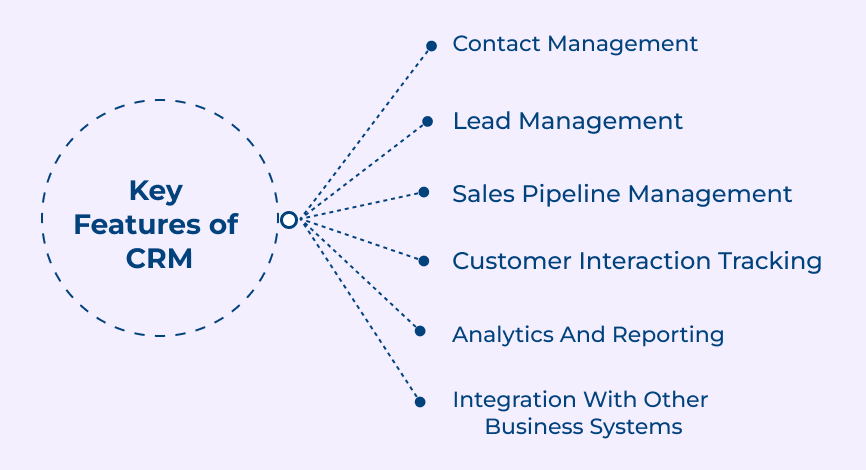
One of the fundamental features of CRM is contact management. It enables businesses to organize customer contact information, including names, addresses, phone numbers, and email addresses. Managing the data effectively enables companies to easily access customer details and track their interactions, making it easier to provide personalized services.
CRM helps businesses efficiently manage their leads throughout the entire customer journey. It allows users to track leads, assign tasks, set reminders, and monitor follow-up activities. Brands can easily prioritize leads with lead management features, nurturing them through targeted marketing campaigns and effectively converting them into loyal customers.
CRM software provides a visual representation of the sales pipeline, allowing businesses to track and manage every stage of the sales process. The feature helps sales teams stay organized, set realistic goals, forecast sales and identify potential bottlenecks. Businesses can make well-informed decisions by having a clear understanding of the pipeline to improve sales performance and optimize their conversion rates.
CRM software allows businesses to track all customer interactions, including emails, phone calls, and meetings. The feature ensures that all communication with customers is logged for reference, helping businesses maintain a comprehensive view of each customer’s history. It also enables teams to collaborate effectively and provide personalized customer experiences based on previous interactions.
CRM systems provide powerful analytics capabilities which allow businesses to analyze key sales and marketing metrics. The features provide valuable insights into the effectiveness of various campaigns, conversion rates, and customer behavior. Leveraging data-driven insights enables businesses to make informed decisions, optimize their marketing strategies and identify areas for improvement.
CRM software can integrate seamlessly with other business systems like marketing automation, social media platforms, and customer support software. The integration enables businesses to streamline their processes, eliminate data silos, and create a unified view of customer data across different departments.
Let us go through the key distinctions of CRM vs CXM to help businesses decide which approach aligns best with their business goals and enhances their customer engagement strategy.
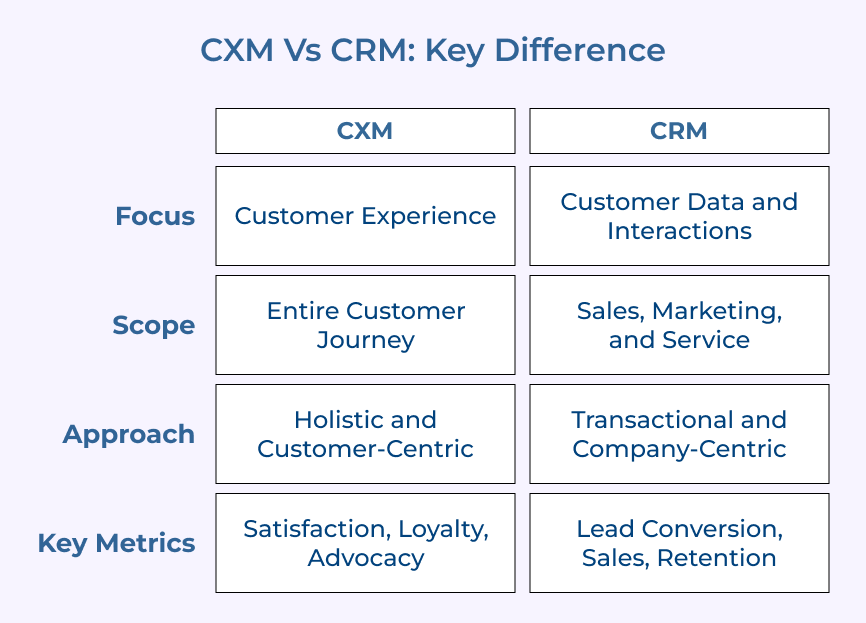
CXM has a broader scope, encompassing the entire customer journey across multiple channels and touchpoints. It focuses on delivering a consistent experience that aligns with the brand’s values and customer expectations. CRM has a narrower scope, primarily focusing on managing customer data, interactions and relationships within the customer lifecycle.
Key Takeaways:
CXM is predominantly customer-centric, prioritizing the individual’s needs, preferences, and emotions. It seeks to understand customer insights, expectations, and pain points to deliver personalized experiences. CRM is more data-centric, emphasizing the collection, analysis, and utilization of customer data for targeted strategies.
Key Takeaways:
CXM is often real-time as it focuses on delivering immediate and relevant interactions based on the customer’s current behavior. It leverages real-time data to provide personalized recommendations and seamless interactions across channels. CRM largely relies on historical data to analyze customer trends and behavior over time, enabling businesses to tailor their strategies accordingly.
Key Takeaways:
CXM is a strategic approach that involves designing and implementing a comprehensive customer experience strategy. It requires a deep understanding of customer needs, desires, and pain points to create memorable experiences. CRM is more tactical as it provides processes to manage customer data, interactions and relationships effectively.
Key Takeaways:
CRM is often seen as a transactional approach, focusing on short-term sales and customer service processes. It aims to convert leads into customers and facilitate repeat purchases. CXM is a more strategic and long-term approach. It aims to build customer loyalty, advocacy and lifetime value by consistently delivering excellent experiences.
Key Takeaways:
The primary goal of CRM is to improve efficiency by optimizing sales and service processes. It helps businesses enhance customer satisfaction by providing efficient and personalized interactions. CXM aims to create emotional connections with customers by delivering outstanding experiences. It focuses on building loyalty, advocacy and long-term relationships.
Key Takeaways:
Explore how leveraging CXM and CRM can transform your business operations and drive significant growth.
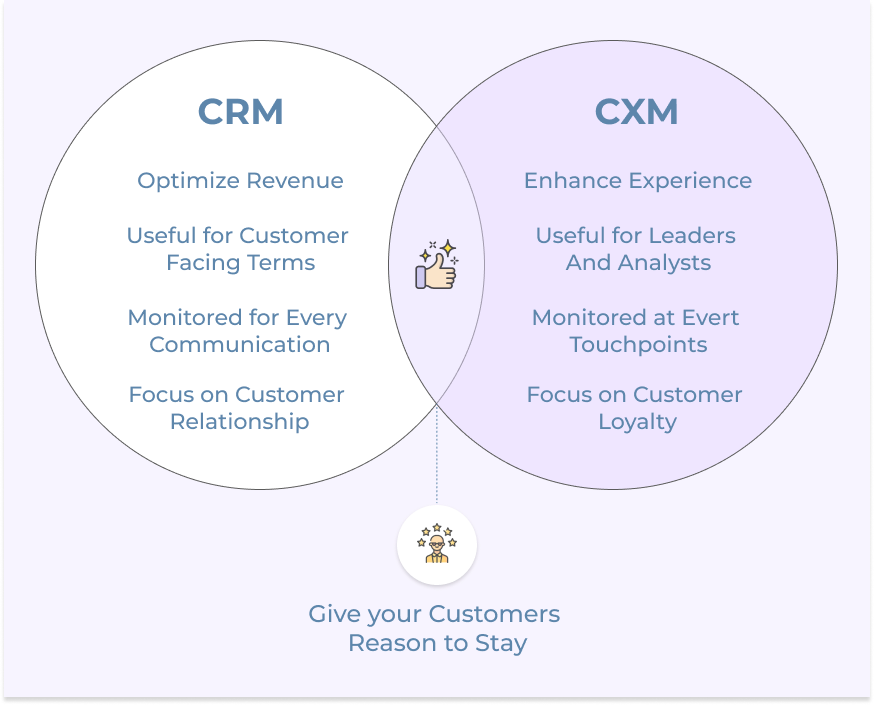
CRM serves as a centralized database for storing customer information, including contact details, purchase history, preferences and feedback. The data is crucial for understanding customers’ needs and preferences, allowing businesses to personalize their interactions. CXM utilizes the data to provide a seamless and personalized experience across all touchpoints, ensuring that customers feel valued.
CRM provides insights into individual customer preferences, enabling businesses to tailor their marketing, sales, and customer service efforts. CXM can deliver personalized experiences that resonate with customers, such as personalized recommendations or targeted offers. The level of personalization helps to deepen the customer-business relationship and promotes loyalty.
CRM helps businesses track customer interactions across various channels, including phone calls, emails and social media. The data provides a holistic view of customer engagement, allowing businesses to identify pain points and areas for improvement. CXM focuses on optimizing the touchpoints to create a seamless and consistent experience, regardless of the channel.
CRM enables businesses to collect and analyze customer reviews, whether it’s through surveys, online reviews, or social media mentions. The feedback is invaluable for understanding customer sentiment and identifying areas where improvements can be made. CXM utilizes the feedback to actively address customer concerns and enhance the overall customer experience.
CRM helps businesses identify their most valuable customers and track customer retention rates. Businesses can implement strategies to nurture and retain valuable customers by understanding customer behavior . CXM focuses on building long-term customer relationships by consistently delivering exceptional experiences.
CRM serves as a central hub of customer information, accessible by multiple departments within an organization. It fosters collaboration between departments (such as sales, marketing, and customer service) to ensure a unified approach to customer interactions. CXM relies on the collaboration to deliver a seamless customer experience across all departments, eliminating silos and providing a holistic view of the customer journey.
After extensively comparing CXM vs CRM, it ‘s clear that the next level of customer engagement lies in the integration of both strategies. While CRM focuses on managing customer data and interactions, CXM goes beyond that to create a seamless experience throughout the customer journey.
Combining both approaches will allow businesses to gain a deeper understanding of their customers, anticipate their needs and deliver unparalleled levels of satisfaction. Adopting a holistic approach allows businesses to stay ahead of the curve and provide exceptional experiences that will set them apart from the competition.
Both CXM vs CRM are crucial for business success, and prioritizing one over the other would be a mistake. CXM focuses on the holistic customer experience, creating loyal and satisfied customers. CRM enables businesses to effectively manage customer relationships and maximize sales opportunities. A successful strategy involves aligning and integrating both concepts, leveraging CRM tools to enhance CXM initiatives.
Start by understanding the customers’ needs, preferences, and pain points. Leverage CRM technology to gather data and gain insights into the customer base. Utilize the information to personalize the marketing campaigns, improve customer service, and enhance the overall user experience. Regularly analyze customer feedback, adapt the strategies accordingly, and invest in ongoing employee training to ensure the success of both CXM vs CRM initiatives.
While it is possible to have a customer experience management strategy without a formal CRM system, it may be challenging to fully optimize the customer journey without the valuable data and insights provided by CRM. CRM allows businesses to analyze customer behavior, enabling them to make data-driven decisions and personalize the customer experience.
CRM focuses on managing customer data to improve interactions and relationships with customers. It includes functions such as storing customer information, tracking interactions, and analyzing data to enhance customer satisfaction. CXM focuses on the overall customer experience and satisfaction. CRM manages data and CXM focuses on using the data to create seamless experiences across all touchpoints.
CXM vs CRM are both essential strategies for businesses to optimize their interactions with customers. Brands can enhance customer satisfaction, loyalty, and retention. CXM focuses on delivering personalized customer experiences, while CRM helps manage customer data and relationships.

Market better, sell faster and support smarter with Veemo’s Conversation Customer Engagement suite of products.
Unify all your customer data in one platform to deliver contextual responses. Get a 360 degree view of the customer lifecycle without switching tools.
Connect with the tools you love to reduce manual activities and sync your business workflows for a seamless experience.
 https://veemo.io/wp-content/uploads/2024/12/customer-service-response-time.png
1256
2400
Webvision Solution
https://veemo.io/wp-content/uploads/2024/11/veemo.svg
Webvision Solution2025-10-17 10:51:142025-10-17 10:51:149 Effective Tips to Reduce Customer Service Response Time
https://veemo.io/wp-content/uploads/2024/12/customer-service-response-time.png
1256
2400
Webvision Solution
https://veemo.io/wp-content/uploads/2024/11/veemo.svg
Webvision Solution2025-10-17 10:51:142025-10-17 10:51:149 Effective Tips to Reduce Customer Service Response Time https://veemo.io/wp-content/uploads/2024/10/How-to-Create-Knowledge-Base.png
1257
2400
Vikas Sachan
https://veemo.io/wp-content/uploads/2024/11/veemo.svg
Vikas Sachan2024-10-21 12:24:342025-11-03 07:13:21How to Create a Knowledge Base in 9 Easy Steps: The Ultimate Guide
https://veemo.io/wp-content/uploads/2024/10/How-to-Create-Knowledge-Base.png
1257
2400
Vikas Sachan
https://veemo.io/wp-content/uploads/2024/11/veemo.svg
Vikas Sachan2024-10-21 12:24:342025-11-03 07:13:21How to Create a Knowledge Base in 9 Easy Steps: The Ultimate Guide https://veemo.io/wp-content/uploads/2024/02/Live-Chat-for-Sales.png
628
1200
teamwebvisionsolution@gmail.com
https://veemo.io/wp-content/uploads/2024/11/veemo.svg
teamwebvisionsolution@gmail.com2024-10-21 11:31:222025-08-06 10:22:06How to Use Live Chat for Sales? 7 Proven Ways to Grow Revenue
https://veemo.io/wp-content/uploads/2024/02/Live-Chat-for-Sales.png
628
1200
teamwebvisionsolution@gmail.com
https://veemo.io/wp-content/uploads/2024/11/veemo.svg
teamwebvisionsolution@gmail.com2024-10-21 11:31:222025-08-06 10:22:06How to Use Live Chat for Sales? 7 Proven Ways to Grow RevenueGrow Customer Relationships and stronger team collaboration with our range of products across the Conversational Engagement Suite.

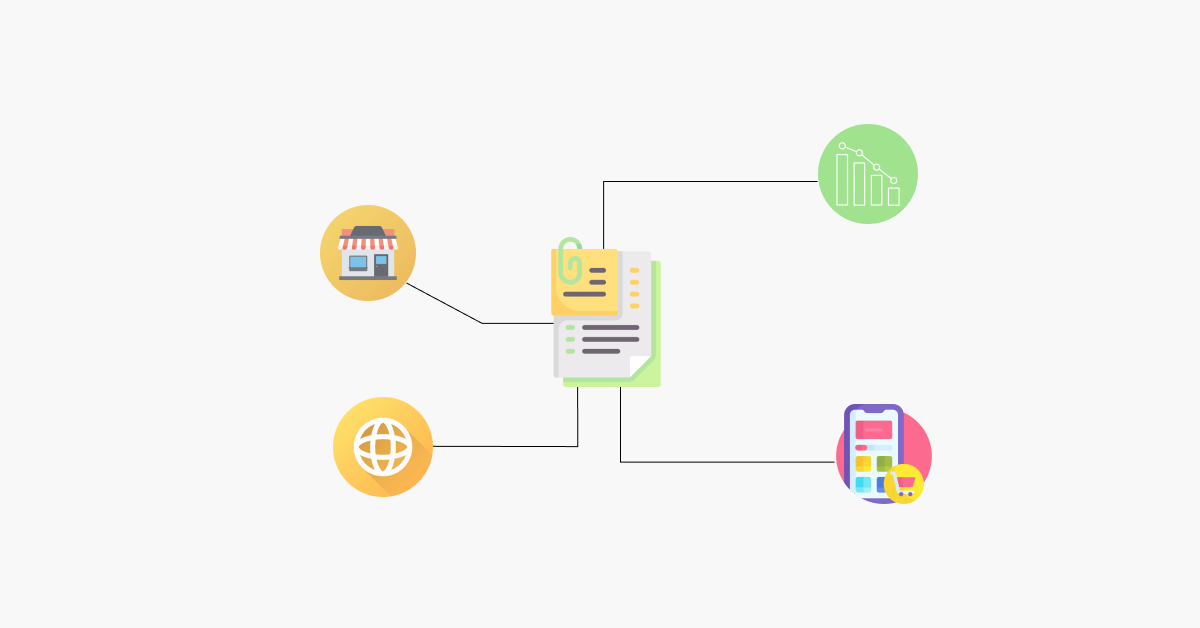 What is Omnichannel Customer Experience? Benefits, Examples & Tools
Scroll to top
What is Omnichannel Customer Experience? Benefits, Examples & Tools
Scroll to top